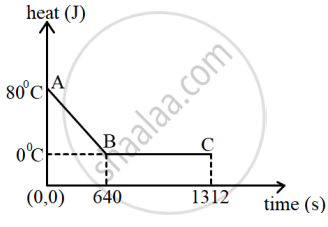Advertisements
Advertisements
प्रश्न
The temperature of 170 g of water at 50°C is lowered to 5°C by adding a certain amount of ice to it. Find the mass of ice added.
Given: Specific heat capacity of water = 4200 J kg-1 °C-1 and specific latent heat of ice = 336000 J kg-1.
उत्तर
Given mass of water = 170 g = 1.17 kg,
Initial temperature = 50°C
Fall in temperature = Δt = (50 - 5) = 45°C = 45K
Heat lost by water = mc Δt
= 0.17 × 4200 × 45
= 3.213 × 104 J
If m' kg ice is added, heat gained by it to melt to 0°C = m'L
= m'C Δt
= m' × 4200 × 5
= m' × 2.1 × 104 J
Total heat gained by ice
= 3.36 × 105 m' + 2.1 × 104 m'
= 3.57 × 105 m' J
By the principle of method of mixtures heat lost by water = heat gained by ice
⇒ 3.213 × 104 = 3.57 × 105 m'
⇒ m' = `(3.213 xx 10^4)/(3.57 xx 10^5)`
⇒ m' = 0.09 kg (90 g)
APPEARS IN
संबंधित प्रश्न
A child running a temperature of 101°F is given an antipyrin (i.e. a medicine that lowers fever) which causes an increase in the rate of evaporation of sweat from his body. If the fever is brought down to 98 °F in 20 min, what is the average rate of extra evaporation caused, by the drug? Assume the evaporation mechanism to be the only way by which heat is lost. The mass of the child is 30 kg. The specific heat of human body is approximately the same as that of water, and latent heat of evaporation of water at that temperature is about 580 cal g–1.
What do you understand by the following statements:
The specific heat capacity of lead is 130 Jkg-1K-1.
A solid metal weighing 150 g melts at its melting point of 800 °C by providing heat at the rate of 100 W. The time taken for it to completely melt at the same temperature is 4 min. What is the specific latent heat of fusion of the metal?
Name the S.I. unit of heat.
Describe a method to determine the specific heat capacity of a solid, like a piece of copper ?
Specific heat capacity of substance A is 3.8 J g-1 K-1whereas the specific heat capacity of substance B is 0.4 J g-1 K-1. Which of the two is a good conductor of heat? How is one led to this conclusion?
Read the passage and answer the questions based on it.
If heat is exchanged between a hot and cold object, the temperature of the cold object goes on increasing due to gain of energy and the temperature of the hot object goes on decreasing due to loss of energy. The change in temperature continues till the temperatures of both objects attain the same value. In this process, the cold object gains heat energy and the hot object loses heat energy. If the system of both the objects is isolated from the environment by keeping it inside a heat-resistant box then no energy can flow from inside the box or come into the box. In this situation, we get the following principle.
Heat energy lost by the hot object = Heat energy gained by the cold object. This is called the ‘Principle of heat exchange’.
- Where does heat transfer take place?
- In such a situation which principle of heat do you perceive?
- How can this principle be explained in short?
- Which property of the substance is measured using this principle?
Explain why the specific heat capacity at constant pressure is greater than the specific heat capacity at constant volume.
The diagram below shows a cooling curve for 200 g of water. The heat is extracted at the rate of 100 Js-1. Answer the questions that follow:

- Calculate specific heat capacity of water.
- Heat released in the region BC.
Two metals A and B have specific heat capacities in the ratio 2:3. If they are supplied same amount of heat then
Which metal piece will have greater mass if the rise in temperature is the same for both metals?
